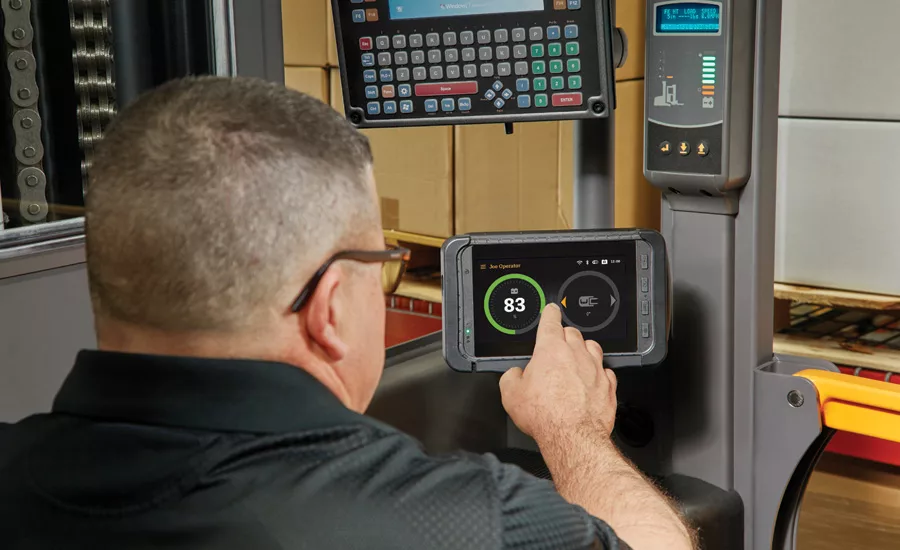Automation impacts forklifts’ data collection, efficiency
Increasing picking efficiency crucial for new forklift design

An indispensable tool in the beverage warehouse, forklifts routinely are used for performing pick, pack and ship functions. With increasing automation, new technologies and burgeoning SKUs driving the beverage industry, forklifts now are being used to gather data and intelligence on productivity, cost management and output within warehouses.
In the past 10 years, forklifts have undergone numerous changes, but continue to be ergonomically designed with worker safety and efficiency in mind, notes Tony Jones, chief executive officer of Doosan Industrial Vehicle America Corp., Bulford, Ga.
“[Forklifts] are now an integral part of most warehouse and manufacturing solutions,” Jones says. “Significant investments have also been made by forklift manufacturers to provide more ergonomic equipment that is aligned with the operator’s movements and tasks to enhance their safety and efficiency, thereby reducing accidents and injuries.
“Automation and new technologies continue to be developed to assist operations within the beverage industry,” Jones continues. “From the receiving dock to the shipping dock, forklift manufacturers are designing semi-automated lift trucks that enable remote control of the equipment during put-away and picking operations.”
Although automation is out in full force in some warehouses, Jones points out that other warehouses are unable to become fully automated, resulting in need for lift trucks featuring intelligent design and operation to improve productivity and safety.
Automation advances
Perry Ardito, general manager of the Jungheinrich Warehouse Products and Automation Group for Houston-based Mitsubishi Caterpillar Forklift America Inc., suggests that the forklift industry has experienced a noticeable shift in customer demand of electric products versus traditional internal combustion (IC) products.
He also notes the impact automation has had on the industry. “Customers continue to look for ways to do more with less,” Ardito explains. “This has resulted in several advances, from more energy-efficient lift trucks to development of both semi- and fully-automated guided vehicles to help customers automate routine processes to improve productivity and accuracy.”
In the area of energy-efficient design, Jungheinrich offers several warehouse products that will run up to two shifts on one battery charge, Ardito says. The company also offers semi- and fully-automated guided vehicles and solutions, including its Warehouse Navigation system to increase productivity as much as 25 percent through semi-automation, while driving down fleet size and reducing labor, he adds.
In addition to energy efficiency, “big data” also is impacting how forklifts are designed, says Collin Rush, general manager for Crown Insite customer support for New Bremen, Ohio-based Crown Equipment Corp.
“Big data applications are already providing managers with information they need to make better business decisions that improve the bottom line, increase efficiencies and position them to keep up with burgeoning demand,” Rush explains. “As forklifts and facilities become more connected, there is a wealth of data that can be gathered through forklift fleet management systems that can be used to provide better understanding of operations and make strategic decisions.”
With data integration presenting more opportunities for forklifts, systems can supply data criteria such as operator performance, equipment status and health, and product management, Rush adds.
Powering up with low-emission options
Experts note that sustainability and alternative power sources like propane and lithium-ion batteries are impacting the forklift industry. For instance, the Washington, D.C.-based Propane Education Research Council (PERC) suggests that propane provides a superior forklift fuel and holds about 90 percent market share for class 4 and 5 forklifts.
Since the 1990s, a shift has taken place in the way of sustainable practices as more businesses are focused on low-emissions operations, says Jeremy Wishart, director of off-road business development at PERC. “While this trend has given rise to electric forklifts, propane has managed to keep pace because one of its best qualities is its low-emissions profile,” he says. ”Propane is a cleaner fuel than diesel and significantly reduces emissions when compared with the site-to-source emissions of electric, too.
“… Propane forklifts have proven their staying power,” he continues. “Their versatility is a huge reason why. Propane forklifts can work indoors and outdoors as the warehouse landscape continues to change. Plus, propane forklifts are available in all weight classes to match the job.”
A PERC infographic highlights that 68 percent of forklifts work inside and outside, and use 76 percent less sulfur oxide than electric-powered forklifts. The good-for-the-environment propane-powered forklifts also contain 17 percent less nitrogen oxide, 15 percent less sulfur oxide and 16 percent less greenhouse gases than gasoline forklifts, according to the infographic.
In addition to being more sustainable, new power sources representing the ergonomics evolution are driving demand. For instance, the Yale End Rider includes such features as integrated knee pads; a hand rail with auxiliary controls that allow operators to access forklift functions from a centralized location; an operator platform with more usable foot space; and an exclusively designed platform cushion that helps absorb shock and vibration, thereby improving operating comfort, says Shelley Bell, industry manager for Yale Materials Handling Corp., Greenville, N.C.
In addition to these ergonomic features, the Yale End Rider has a Precision Pick feature that enables operators to control the speed and coast functions in both directions with the press of a button, fostering easy navigation between pick locations while shaving seconds off each pick, Bell adds.
“The end rider’s Smart Shift bundle enables shortcuts to improve operator efficiency,” she explains. “Operators can raise and lower forks with a single touch, and use the cruise control system to relax over long hauls. The Smart Acceleration feature automatically selects two distinct acceleration profiles based on application, load and task, while the Yale Smart Slow Down automatically reduces speed in cornering for improved stability.”
For customers interested in alternative power sources, Crown soon will release its V-Force Lithium-Ion Energy Storage System (ESS) for the Crown WP Series pallet truck, which includes a UL listed lithium-ion battery pack, a compatible charger and a fully integrated battery management system to extend battery life. A truck display also will alert the operator before truck operation ceases, Crown’s Rush adds.
Part of the company’s full line of V-Force forklift chargers, the V-HFM3 Series of modular battery chargers for lead-acid and lithium-ion batteries is designed to help facility managers reduce energy costs and extend the life of their forklift batteries.
“Users gain energy savings through a 97 percent efficiency performance level of the V-HFM3 Series, which is more efficient than similar high-frequency chargers,” Rush says. “They also require a smaller footprint and are lighter in weight compared to prior models.”
Adapting to more SKUs
Not surprisingly, SKU proliferation, consumer trends aimed at more personalization, and diverse choices are fostering the need for greater product variations in smaller quantities, which require more retail-friendly deliveries, Doosan’s Jones says.
“These mixed pallets of products allow stores to replenish directly to shelf, making the transfer of product and pallet-building more challenging for beverage distributors,” Jones says. “… This creates a need for safety-driven, flexible, intelligent and efficient material handling equipment for operators.”
In the past five years, Doosan has redesigned and upgraded its Heart of the Line models as well as other higher capacity forklifts. The company also has introduced new products that are focused on providing increased savings on operating costs, powerful performance and superior ergonomics.
Among the beverage trends impacting forklifts, Jones points to the need for more space in existing warehouses, which can be solved through higher, 11-feet racking designs, longer run times with enhanced battery power, greater visibility of pedestrian traffic and the ability for forklifts to lift varying loads of diversified SKUs.
“Doosan has adopted high visibility masts and rails that provide 30 percent increased visibility that is now available with our new 7-Series Electrics and 9-Series Cushion forklifts, released in 2016 through 2019,” Jones says.
Mitsubishi’s Ardito affirms that the explosion of SKUs has resulted in “the need to rethink how product is stored and moved, with more product being picked from the first, second and even third levels of racking, if not more.”
“Customers are now considering alternative order picking models — from low-level and high-level order pickers for case and piece picking to turret trucks for full pallet picking and put-aways,” Ardito says. “With the growth in SKUs comes the additional challenge of having enough storage solutions (slots) in the warehouse or distribution center, therefore, greater storage density is needed along with finding more productive, efficient, safer and less costly solutions to the picking process.”
In response to the Internet of Things (IIoT) and the big data boom, Yale’s Bell notes that the future of material handling lies in cloud connectivity that allows software and services to globally be linked over the Internet.
“In 2006, there were 2 billion ‘smart’ devices, and by 2020, there are expected to be 200 billion,” Bell explains. “… This opportunity for machine-to-machine communication allows users to enable automated functions and harness real-time operational data to make informed decisions in the warehouse.
“One way to incorporate IIoT in the warehouse is to equip forklifts with a telemetry system such as Yale Vision,” she continues. “These systems harvest data from the truck to automate service calls, evaluate operator performance, digitize OSHA checklists and more.”
Yale Vision brings the IIoT not only to Yale lift trucks, but other mobile warehouse equipment, regardless of manufacturer, Bell adds. In January, the company released its Yale Vision mobile app, which brings more efficient fleet management to the warehouse, according to Bell. The app enables users to view utilization metrics and receive notifications when impacts or errors occur on pre-shift safety checks.
Bell notes that the beverage industry will continue to address the issue of labor availability and retention with new innovations in robotics and training tools, to automate certain tasks while easing adoption and improving operator confidence. BI
Looking for a reprint of this article?
From high-res PDFs to custom plaques, order your copy today!





